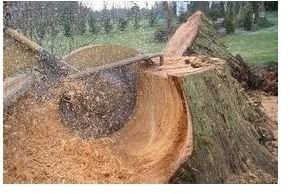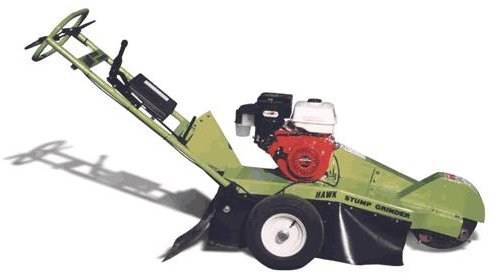Learn How to Use a Stump Grinder Safely & Effectively
Use a Stump Grinder Safely and Effectively
A tree stump left over from an old, or recently cut tree can be hazardous if it is located in an area where there is foot traffic or if it’s simply situated in an inconvenient place.
Removing the stump will allow you to re-plant the area or use it for whatever purpose you wish.
Although tree stumps do eventually rot and can be removed with a shovel and ax, this process of disintegration can take months if not years. Covering the stump with soil can speed the process, but in case that unsightly stump is just too much hassle and you want it out as soon as possible, the best way is to rent a stump grinder.
Renting a Stump Grinder
Stump grinders come in a range of sizes and you will need a grinder that is suited to handle the size of the stump you want to remove. They can be rented from companies such as those that supply landscape maintenance machinery or from the larger hardware stores like Home Depot. Costs on average will range from $100 a day and upwards, depending on the size of the grinder and for how long you wish to rent it.
The first step is to find the stump grinder that is suited for the job and the best way to find this out is to discuss your requirements with the rental company. They can deliver the grinder to your property for an extra charge, which is a good idea if you are renting a large grinder, or you can load it onto the back of a truck or trailer. It is also a good idea to have them explain to you how to operate the machine before renting it.
Stump grinders can cost thousands of dollars to purchase, so it is not cost-effective if you only intend to use it once in a while. Renting by the day is usually the best option.
Protective Gear

It is important for your own safety to wear protective gear while operating a stump grinder. The machinery is noisy, so ear protection is necessary. Use ear muffs, ear defenders or other effective hearing protection.
Goggles are crucial to avoid getting splinters in the eyes in case of flying debris. Leather work gloves will help protect your hands. Steel toe capped boots are always advisable when operating machinery and clothing should be comfortable but not overly loose. Tie long hair back out of the way.
Preparing the Stump Area
- Dig around the stump area with a shovel, removing any vegetation or grass present. Loosen up the soil as deep as you can go.
- Remove any stones or other large debris that might get in the way and clear the area where you intend to work so that you have enough room to to move without tripping over any tools or other things.
- Saw the stump down to just a few inches above the ground if possible, before you use the stump grinder. This can make the job easier and quicker.
- Keep family and pets away from the area for their safety.
Using the Stump Grinder
Stump grinders have large cutting wheels, or blades, with steel teeth. Do not stand near the blades when the engine is running.
- The first step is to position the grinder in front of the stump, ready for use.
- Read any instructions on how to operate the machine and study the control panel on the grinder before using it. Instructions and control panels may vary depending on which model is being used.
- Many of the controls should be hydraulic, making it easier to use with very little force needed. Using the controls, adjust the height of the grinder wheel to a few inches above the top of the stump.
- Drive the machine forward to position the grinder wheel directly above the center of the front edge of the stump.
- Engage the grinder wheel so that it will cut the stump when you lower it onto the wood.
- Lower the grinder so that it cuts two to three inches into the stump.
- Now use the controls to slowly swing the grinder wheel back and forth so that it cuts all the wood away that it can cut in its current position.
- Lower the grinder another inch or so into the wood. Repeat the slow swinging motion to cut away all possible wood.
- Now raise the cutter a few inches above the top of the stump again, and move the entire machine forward again so that the cutter is directly over the front edge that was left after your last cut.
- Repeat the above until you have slowly cut the stump down in layers of about four inches. Continue until you have cut it down as low as you want it to be.
References
- Photos courtesy of Safety Culture http://www.safetyculture.com.au/work-method-statements/Stump_Grinder_Procedure.php and Finco Tree Service http://www.chopatree.com/
- Popular Mechanics. Do-It-Yourself Tree Stump Grinding, http://www.popularmechanics.com/home/improvement/lawn-garden/1273711
- Health and Safety Executive. Mobile Stump Grinders, http://www.hse.gov.uk/pubns/afag606.pdf
- Larry’s Rentall. Stump Grinder Safety, http://www.larrysrentall.com/pdf/operator_instructions/instructional_safety_sheets_stump_grinder.pdf
